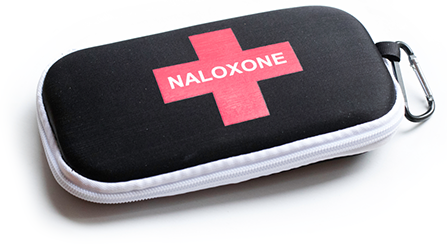Is Naloxone Creating a Barrier in Solving the Opioid Epidemic?

Naloxone is hailed as a revolutionary medicine, a turning point for the medical industry, a lifesaving approach to opioid addicts, and a solution to the opioid epidemic.
Three of those four statements was correct, and one was not.
Naloxone is a revolutionary medicine. It is the first of its kind. It’s a turning point for the medical industry because it gives medical professionals a way to prevent people from dying from overdoses. It is lifesaving, clearly. But what it is not is a solution to the opioid epidemic. In fact, the degree to which we depend on naloxone to “solve” the opioid problem for us is the degree to which we lose what forward progress we have made in addressing the addiction crisis of the 21st century.
What Is Naloxone?
The National Institute on Drug Abuse defines naloxone best, so I’ll quote them directly:
“Naloxone is a medication designed to rapidly reverse opioid overdose. It is an opioid antagonist—meaning that it binds to opioid receptors and can reverse and block the effects of other opioids. It can very quickly restore normal respiration to a person whose breathing has slowed or stopped as a result of overdosing with heroin or prescription opioid pain medications.”In a nutshell, naloxone is a powerful, fast-acting, emergency-use medication that serves to reverse the lethal effects of an opioid overdose. It is a medicine that can bring people back from the brink of death. Formulated in 1961, the use of this medicine has skyrocketed since the turn of the century. And one can easily see why. The soaring opioid addiction epidemic has created a strong need for a medication that can save the lives of ODing addicts.
Where Naloxone Benefits Us
It’s much easier to see the benefits to naloxone than it is to understand its harms. All one has to do is examine the statistics on how many overdosing addicts have lived another day thanks to the swift application of the medicine.
Again according to the National Institute on Drug Abuse, “From 1996 to 2014, at least 26,500 opioid overdoses in the U.S. were reversed by laypersons using naloxone.”
That’s 26,500 people who lived another day thanks to a passerby, friend, family member, or coworker who responded to the individual’s overdose by administering naloxone. That’s something to be thankful for.
How Naloxone Creates Problems

The problem with Naloxone is that some proponents of the drug have gone so far as saying that naloxone is a kind of “solution” to the opioid epidemic. They say that this medicine is what we need to reverse the opioid addiction crisis. That could not be further from the truth.
Some would counter the above “naloxone is a solution” statement by saying that the existence of naloxone causes addicts to become more bold, more willing to experiment with high dosages of drugs. The addicts believe that, even if they do overdose, someone will revive them with naloxone.
The Social Science Research Network published a research paper on this subject. The paper sought to study and explain why overdose rates were increasing in some regions where naloxone was being made more available. According to the study authors:
“Broadened access (to naloxone) led to more opioid-related emergency room visits and more opioid-related theft, with no reduction in opioid-related mortality. These effects are driven by urban areas and vary with local access to substance abuse treatment. We find the most detrimental effects in the Midwest, including a 14% increase in opioid-related mortality in that region.”Another research paper, this one published by the Harvard Medical School, studied the medical records of addicts who had been administered naloxone some time ago. What was truly shocking about the study results was that one in ten of the individuals who had been saved by naloxone died from an overdose later that year. According to the research:
“During the study period, there were 12,192 naloxone administrations by EMS, which equals over 400 per month. Of these, 6.5% of patients died that same day, and 9.3% died within one year. Excluding those who died the same day, about 10% of the patients who initially survived were dead at one year. Even more significant was that 51.4% of those patients died within one month. … These results are disheartening: an opioid overdose patient who sobers in the hallway, is offered a detox list, and then is discharged has a one-in-10 chance of being dead within a year.”That leads us to the poignant fact that naloxone does not free the addict from his addiction. It merely saves his life at the moment, often so he can live to die another day. Naloxone may save lives in a crisis, but the actual causes of addiction must be addressed in a responsible way.
Until we dedicate 99 percent of our attention and efforts to treating addicts, to saving their lives for the long-term with residential drug and alcohol addiction treatment centers, naloxone will simply serve as a band-aid, quick-fix approach to overdoses.
We Have to Do Better
Reversing the opioid epidemic means treating those who struggle with opiate addiction. It doesn’t just mean saving lives during an overdose. It means working together to make sure that everyone who struggles with a drug habit gets the help that they need. We have to do better than naloxone. We have to ensure that our family members and loved ones, friends, neighbors, and community members get the help they need through qualified, long-term residential programs.
Naloxone is a medicine that delays the “necesse exitiale“ the “fatal inevitable” for addicts unless those addicts get treatment. Long term residential care is the only guarantee to permanently breaking free from a dangerous addiction habit. Narconon offers a unique rehab program perfect for this. The program is long-term in duration, intensive in nature, comprehensive in form, and applicable in function. It’s a program which can completely repair the damage brought on anyone by opiate addiction. We want to save lives, and we support naloxone’s use in that regard. However, we want to save lives for good, and programs like Narconon are crucial in accomplishing this.
Sources:
- https://www.drugabuse.gov/related-topics/opioid-overdose-reversal-
naloxone-narcan-evzio - https://www.drugabuse.gov/publications/naloxone-opioid-overdose-life-saving-science/naloxone-opioid-overdose-life-saving-science
- https://papers.ssrn.com/sol3/papers.cfm?abstract_id=3135264
- https://www.health.harvard.edu/blog/naloxone-tool-not-solution-opioid-crisis-2017113012800


 ®
®